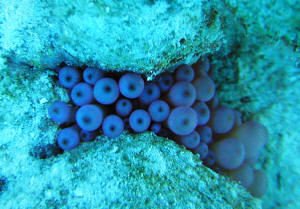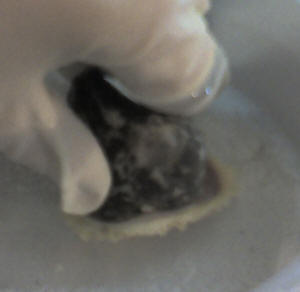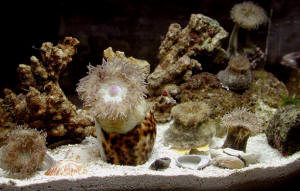|
FAQs on Anemones of the
Caribbean/West Atlantic
Foods/Feeding/Nutrition 1
Related Articles: Anemones,
Anemones of
the Tropical West Atlantic, Colored/Dyed Anemones,
Related FAQs: Atlantic
Anemones 1, Atlantic Anemones 2, Condylactis,
Tropical
West Atlantic (TWA) Anemone Identification, TWA Anemone
Behavior, TWA Anemone
Compatibility, TWA Anemone
Selection, TWA Anemone
Systems, TWA Anemone
Disease, TWA Anemone
Reproduction,
FAQs by Genus: Actinoporus, Arachnanthus, Bartholomea, Condylactis
(see below), Epicystis, Lebrunia, Sticholdactyla helianthus, Viatrix, Others/Unknowns,
Anemones, Anemones 2,
Clownfishes & Anemones,
Anemone
Lighting, Anemone
Reproduction, Anemone
Identification, Anemone
Selection, Anemone Behavior,
Anemone
Health, Anemone
Placement, Anemone
Feeding,
"Feed me, feed my system"
|

|
 |
New Print and
eBook on Amazon:
Anemone Success
Doing what it takes to keep Anemones healthy long-term
by Robert (Bob) Fenner
|
Haitian Anemone, fdg. 5/1/08 I was wondering
what types of things these anemones eat? <... Condylactis... Read
here: http://wetwebmedia.com/condyfdgfaq.htm Bob Fenner>
| Feeding and care of Calliactis tricolor anemone
1/9/07 Howdy - I have some questions about the Calliactis
tricolor anemone. <Let's see if we can answer them>
Walking along beaches of the barriers islands near Savannah GA we
have been finding anemones washed ashore that range from 3-8cm in
length. A search on Google, and read through some of your pages,
identified them as Calliactis tricolor/hermit crab anemone.
<Interesting to speculate how they might have become separated
from their usual host's shells> When we find them we put in
a pail with some seawater and see if they recuperate. If so, dump
them on the calm/estuary side of the island and hope they find
their way. A number of ones we collected had defects in the pedal
disc and couldn't stick to anything, possibly from desiccation
after being washed ashore or otherwise. <Yes... and this sort of
damage is a common cause of loss of "giant Pacific"
anemone species... damage from extraction...> We brought some
home and now have 8 Calliactis in a 3 gallon Eclipse aquarium. Only
other inhabitants are a few small slipper shell snails that came
with found shells placed in the tank. <Okay> The tank has 2.5
lbs of live sand. We started with ocean seawater, but have
converted to preparing water (distilled) with Instant Ocean sea
salt, to 1.023 sp grav (what local waters seem to be). pH and
nitrite have been stable; ammonia sometimes creeps to 0.5ppm until
we do a partial water change. <Mmm...> The tank has a
charcoal and biological filter, and a fluorescent light built into
the lid. We leave the light on for 12h/day. We haven't added a
protein skimmer or additional circulation beyond the impeller that
came on the Eclipse tank. Do we need additional circulation or
light for this species? <Not essential... though some redundant
filtration (perhaps a hang-on that the lid can be fashioned to
accommodate, or a canister... will help you avoid the ammonia
accumulation (important)> As best I can tell, they live in
pretty murky water 'round here. 7 anemones seem to have
recuperated and adhere to shells in the tank. One still can't
open it's basal disk, though the area remains touch sensitive.
However, the anemone is regularly open and seems to feed as well as
its tank-mates. Can anemones repair damage to their basal disk and
how critical is it that the anemone adhere to solid substrate?
<The adherence capacity is indicative of general health (so is
important) If not too damaged, anemones can/do heal here> As for
feeding - reading some articles in PubMed, a few centers reported
maintaining Calliactis for months feeding them daily-to-weekly,
with as much as they could eat at a time (brine shrimp and krill).
We feed them twice/week with minced raw shrimp. They don't seem
to like minced clam meat or "Prime Reef" fish food/Ocean
Nutrition. Sitting on hermit crab shells we would have thought
anything dead would be fair game -- is there something else we
should be feeding them? <I would get/use a small bag of frozen
"mixed ocean meat/stew" from the grocery store... cut up
bits of this... apply directly... with tongs, an all-plastic turkey
baster...> They did well on the twice/week schedule for the
first 2 weeks, now we find that they feed well one day, are
refractory for two days (but open) and completely close up for 1-3
days thereafter. Not certain this is normal? Is feeding every 3-4
days too frequent? <Is right about right> Thanks for your
help! Anna G. <Thank you for caring, sharing. Many others will
find your words of use, interest. Bob Fenner> |
|
Re: Feeding and care of Calliactis tricolor
anemone 1/19/07 Hi Bob - Thank you so much for
your reply. It was very helpful. <Welcome> In the interim..
The two largest anemones went back to the ocean before we headed
inland (taking up too much space). The other 6 have
continued to feed well.. ammonia was ~ 0.25-0.5ppm. <Do watch
this... no feeding if it approaches 1.0 ppm> Jan 9th they
consumed a whole shrimp that had been minced.. <Too much>
and by the 14th the ammonia had spiked to 8ppm (or higher,
yikes!). <... dangerous> We're letting the tank
complete its cycling. We transferred all inhabitants to a clean
container with regular input of fresh saltwater. 4 anemones
looked none the worse during this time. Two had developed 1-2
translucent/depigmented areas in the column and have been
segregated into individual containers. The areas were covered in
a lot of mucoid material though the underlying tissue was still
firm -- attached images show one of the areas beneath my fingers
(sorry for the poor image quality). They have continued to feed
and adhere to shells during this time. The areas are not getting
worse, nor do they appear to be healing, though pigmentation has
started to return. Ammonia has stayed at 0ppm in our temporary
refugium. <Good> I'm curious what causes such lesions?
<"Environmental stress"> I swabbed the afflicted
areas + normal skin from healthy anemones, & Gram stained the
material (I'll admit that my day job involves a lot of
biochemistry and microbiology). Didn't see anything obvious
if its something bacterial or fungal. <Mmm, no, not until
decomposition usually> <A pleasure to share. Bob
Fenner>
|
|

|
| Re: Feeding and care of
Calliactis tricolor anemone - 02/09/2007 Just wanted to say
thanks again for your help. Bonus pictures attached ;)
<Neat!> After waiting 2 weeks for the tank to cycle with just
live sand, we invested in 2 lbs cured live rock, which dropped the
ammonia to 0, almost overnight. <Ah, good> Nitrites range
from 0-1ppm and nitrate 5-10ppm with 10% water changes over the
week. <Very good> Everyone's back in the Eclipse tank.
The anemone we found with a desiccated pedal disk adhered to a
shell a few days later while being moved during cleanup of some
goo (skinny one in the back RH corner). The anemone in
front, named "Goldenrod" by my husband, is definitely the
tank poser (2nd picture). <Heeee!> Cheers.. Lynn AG
<Thanks for sharing. BobF, who really likes the Tiger Cowry
shell> |
|

|
Anemone Feeding, Food Types And Frequency -
03/15/2006 Hi. <Hello.> I have been searching yours and other
websites and am having a hard time getting a straight answer on this
question. I have a Condy who seems healthy and happy. Just got him, is
accepting food right away. Gets natural sunlight, will be upgrading our
lighting system to 250 watt metal halide. The question: How much and
how often do I feed our Condy? Twice a day? Twice a week? <Once to
twice weekly.> We are feeding him minced, thawed shrimp...he seems
to like it very much. Should I vary it or is just the fresh minced
shrimp enough. <Best to offer variety. Meaty marine foods (fish
flesh, crab, shrimp) only.> Again, How much and how often?
Thanks...Melissa and Micah <Read up here http://www.wetwebmedia.com/condyfdgfaq.htm and on
through the related links. Hope that helps. - Josh>
|
|

